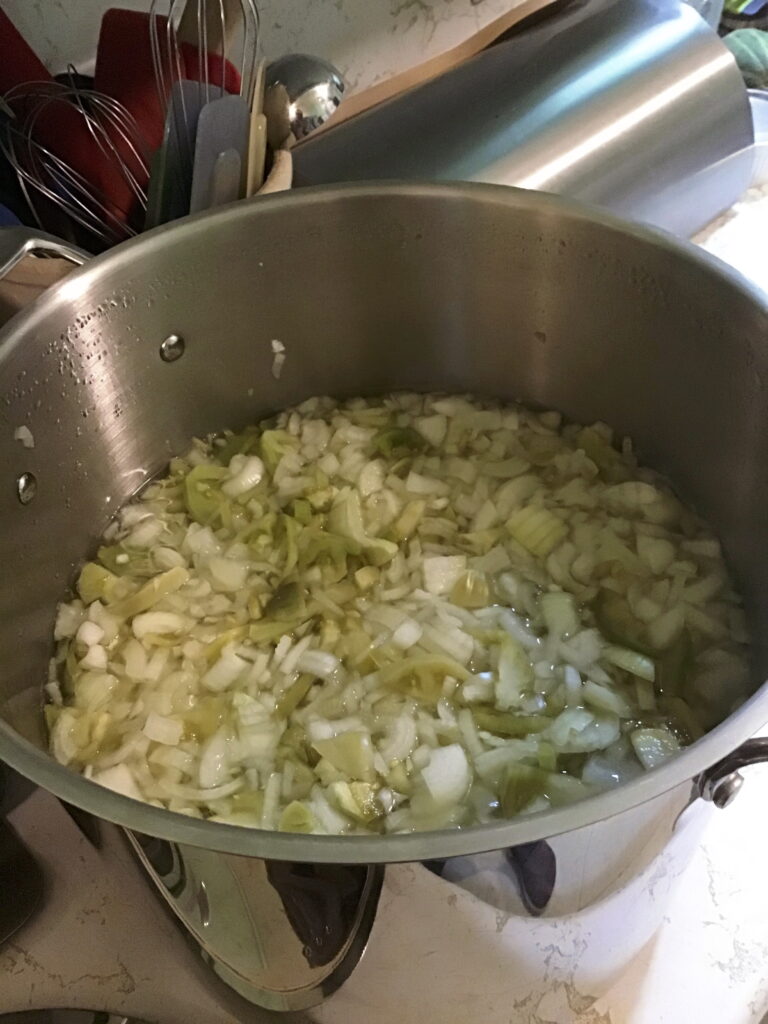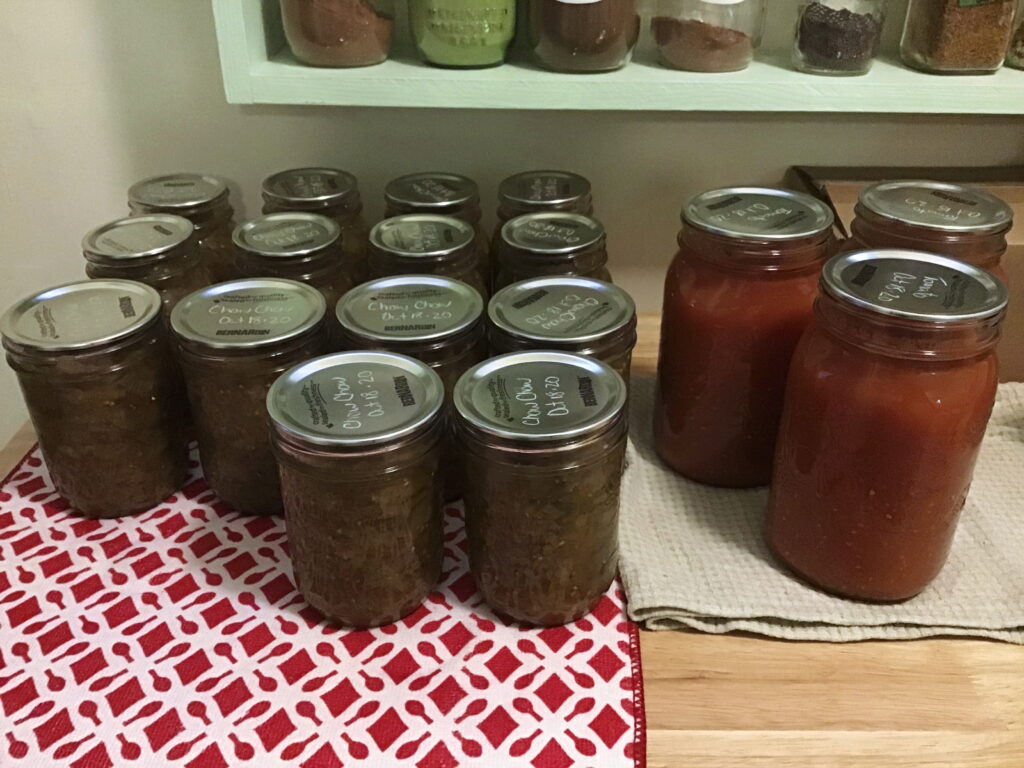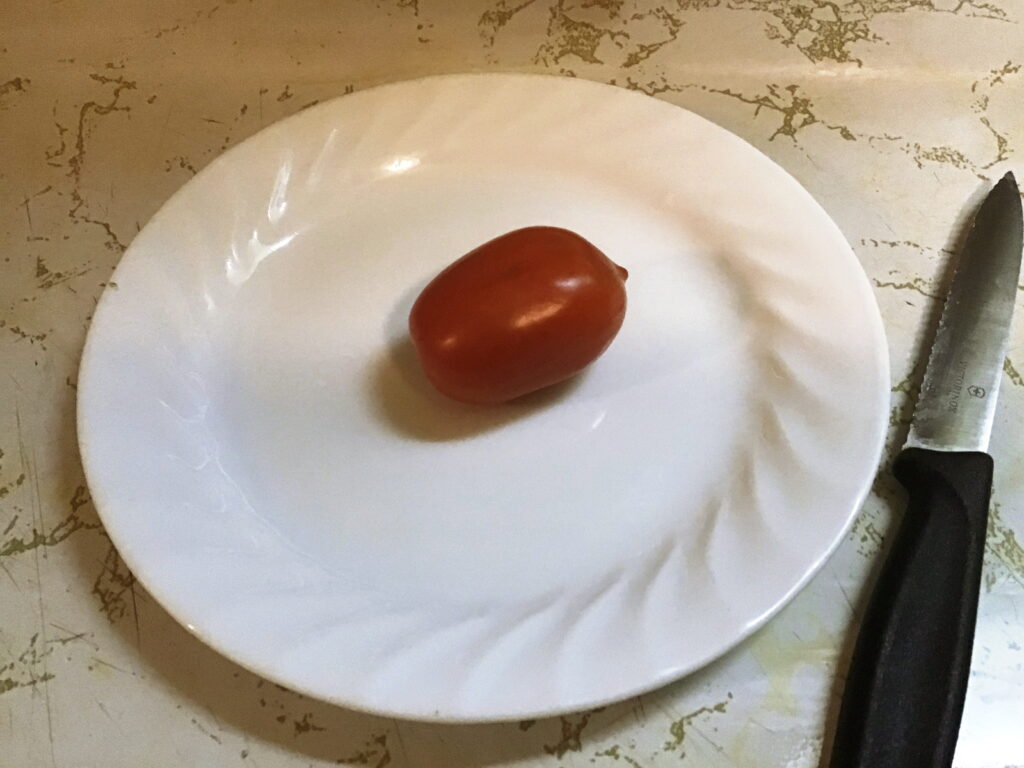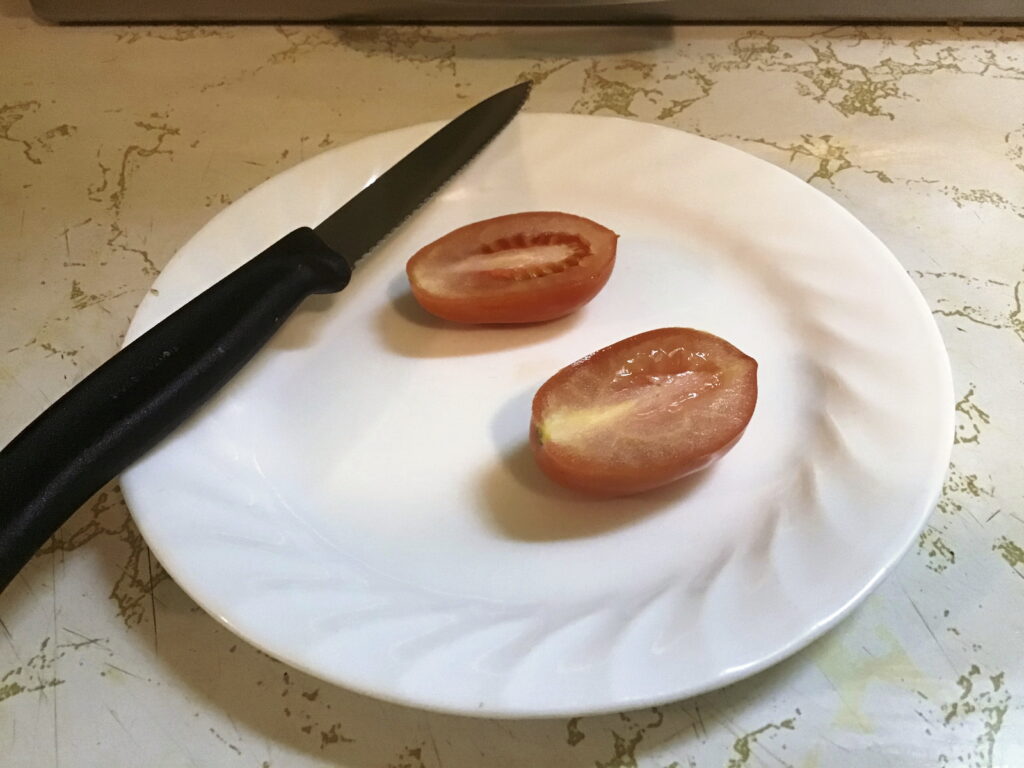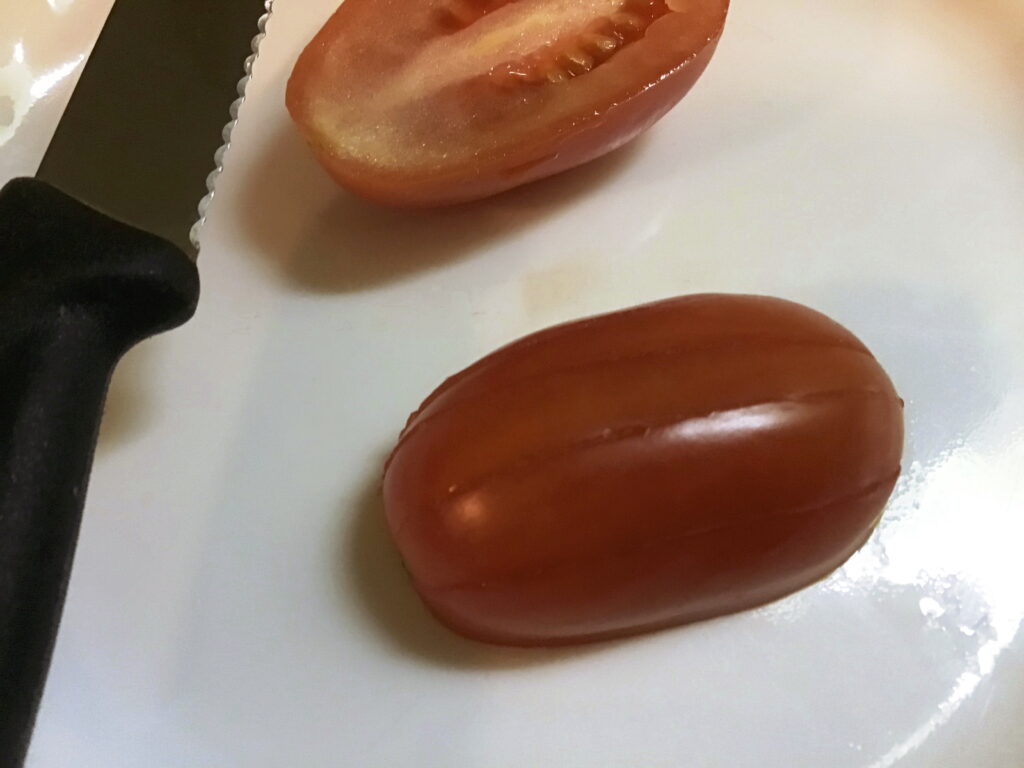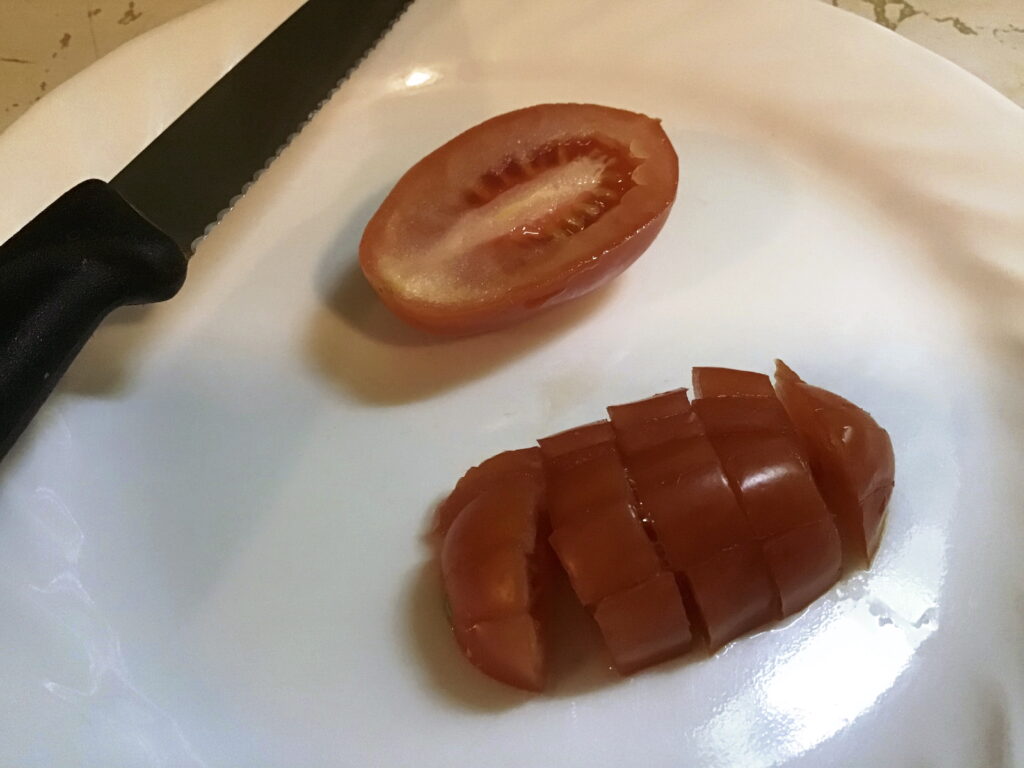Yesterday was the Big Tomato day.
Attila had been harvesting green Tomatoes every day until the last frost, and even now he is bringing a few in every day. Our living room, small and busy as it is, has become a Tomato Haven. Bowls and trays of ripening Tomatoes cover every available flat surface in the room. We have left room on the table for our plates so that we can eat our dinner, one seat each in easy chairs, and enough room on the floor to make our way in and out of the room. We are surrounded by green and ripening Tomatoes!
Some of the Tomatoes brought in were just too small to ripen properly, we knew we would lose them if we tried to ripen them. So I pulled out my homemade canning recipe book and perused my green Tomato recipes, and the ingredients we had on hand. I favoured another batch of Mincemeat, but it required citrus fruit and we had none. Finally, after discussing it with Attila, we decided upon Chow Chow, because we love it, and because we had all of the ingredients needed: green Tomatoes, Onions, Apple Cider Vinegar, sugar, and spices.
The process started on Saturday, when 10 pounds of green Tomatoes, and 5 pounds of onions were chopped (by Attila!), and set in brine to soak overnight. Sunday morning the vegetables were well rinsed. Apple cider vinegar, sugar, and spices were added, and the 16 quart stock pot was almost full. The mixture took an hour to come to a boil, then simmered for 90 minutes before being jarred and canned. It made 14 500-ml jars of Green Tomato Chow Chow. The canner only holds 7 wide mouthed canning jars, so two canning sessions were in order. I am now completely out of 500-ml canning jars!
After: 14 500-ml jars of Green Tomato Chow Chow, and 3 1-liter jars of my Tomato Sauce.
But that was not the last of the Tomato projects for the day.
There were scads of Tomatoes that had ripened. We worked together, Attila washing and removing unwanted bits from the Tomatoes, and me slicing them for the food processor. Our labours yielded 3 1-liter jars of pureed Tomato Sauce.
Last year, and again this year, I have adopted an “unsafe” technique of canning my Tomatoes. “Unsafe” because this method has not been tested properly, so anyone using it is doing so at their own risk, and it is not recommended for beginners.
My method was developed by me, to accommodate our way of using canned tomatoes in cooking. They are an ingredient in soups and casseroles, and we both find it acceptable to use pureed Tomatoes without chunks. The reason given by the USDA, and University Extension Agencies, for not testing canning Tomatoes with the skins, is that the skins are unpalatable. When canned the skins become rolled, sharp, and almost impossible to eat. So including the skins has not been tested and found unsafe, it is deemed “unsafe” because it has not been tested. All recipes that have not been tested are deemed “unsafe” by the USDA and University Extension Agencies, with VERY GOOD REASON. Canned foods sit at room temperature for long periods of time, so that preserving food by canning is a completely different thing than cooking food. Since Botulism kills, and is invisible, and is easy to prevent if canning is done properly, tested recipes will ensure that home canners remain safe. It is isn’t difficult to can safely, not at all. But when deviations such as mine are used, there is always a risk involved. NOTE: for tested recipes and approved techniques see The National Centre for Home Food Preservation, my go to site for everything canning related.
Enter the high powered Food Processor, which will puree the Tomato skins into tiny bits, which are unnoticeable to us in cooked food. I help the food processor along by scoring the skins from top to bottom, about 1/4 inch strips, then dicing across the scoring. After pureeing the Tomatoes, they are placed in a large stock pot and brought to a boil for 10 minutes. 1/2 teaspoon of Citric Acid is added to the hot canning jars before ladling the hot Tomatoes into the jars. I have been using 1/2 inch head space. The jars are steam canned for 40 minutes.
My research revealed that the skins are more acidic than the Tomato flesh, so that including them increases the level of acidity, which is desirable for canning. Since I add 1/2 teaspoon of Citric Acid to each 1-liter jar of pureed Tomatoes, I speculate that the danger of botulism is eliminated, but I cannot prove it. So the the way I can Tomatoes is officially an “unsafe” technique.
I have actually written to several University Extension Agencies requesting that this technique be tested, but have received no response. There is little in the way of funding for this type of rigorous testing, so I am not surprised that my obscure way of canning Tomatoes is not a high priority for lab time. Still, it was worth a try.
There are several reasons I developed this technique of canning our organic garden Tomatoes. First, I regard Tomato skins as an excellent source of nutrition, and worth saving. When I peel Tomatoes for canning there is an extra step, the skins are saved, dehydrated, and powdered as an ingredient for cooking. It is much easier to score, slice, and puree than to peel, and there is no need for the extra step of preserving the skins.
This morning I labelled all 17 jars of Tomato products, washed them all with soapy water to remove any bits of jar content that might have escaped through the canning process, and set them to dry thoroughly. When they dry they are taken two at a time down the basement stairs to be stored on a shelf. I get my exercise!
Worldly
Weather
8°C (22C in the house, unheated)
Date: 9:00 AM EDT Monday 19 October 2020
Condition: Light Rain
Pressure: 102.5 kPa
Tendency: Rising
Temperature: 8.4°C
Dew point: 7.5°C
Humidity: 94%
Wind: NE 7 km/h
Visibility: 24 km
Quote
“All married couples should learn the art of battle as they should learn the art of making love. Good battle is objective and honest – never vicious or cruel. Good battle is healthy and constructive, and brings to a marriage the principle of equal partnership.”
Ann Landers
1918 – 2002
